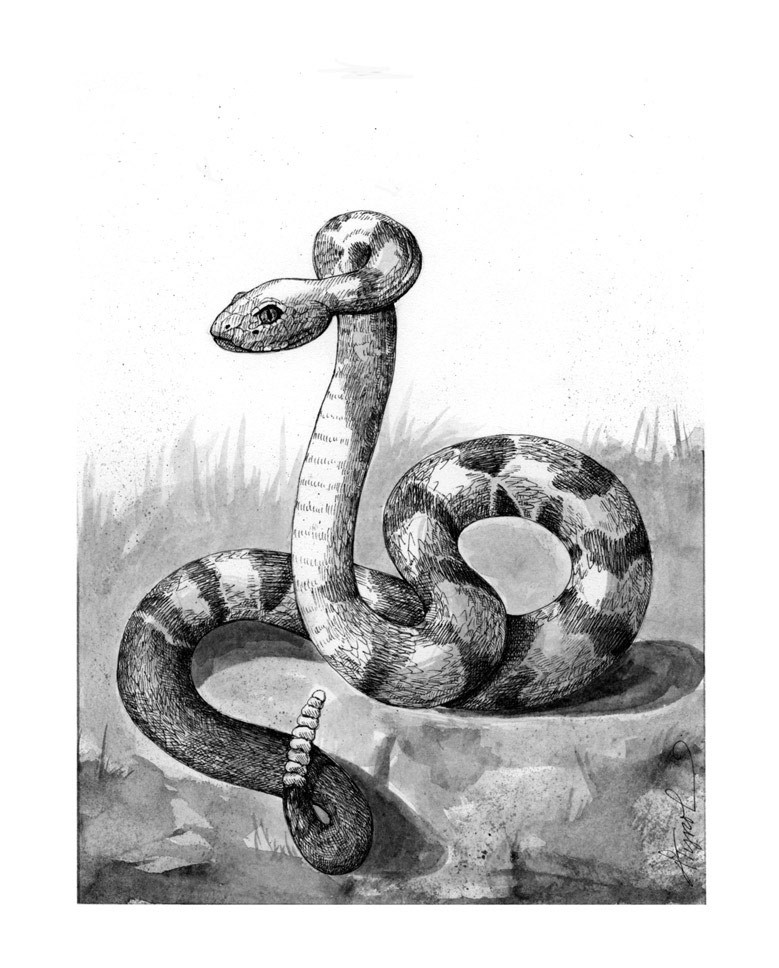
No one has been bitten by a rattlesnake in Vermont in over 50 years. But that streak ended last year when a man in Fair Haven was struck between the thumb and index finger by a snake as he was attempting to move it off the road with a stick.
Game warden Don Isabelle told the Rutland Herald, “I think it’s important to get the message out that snakes aren’t necessarily lying in wait to ambush people. It’s actually the opposite — they’re very timid and docile. This individual was just too close. Doing what he did, that’s not a wise move.”
If the man was trying to help the snake off the road, he had one thing right: rattlesnakes and roads don’t mix. Recent research across the border in New York found that rattlesnake populations are severely limited by roadways.
Originally found across much of New England, timber rattlesnakes (Crotalus horridus) are now extirpated in Maine and Rhode Island. They may vanish soon from New Hampshire. Historically, there were about 20 den sites in Vermont. Now, biologists know of just two, and estimate there are perhaps just a few hundred snakes left. Most people considered them vermin until relatively recently. Vermont paid a bounty of a dollar a tail until 1971 and then turned around and listed them as an endangered species in 1987, making it now illegal to kill or harass them. Despite their timid nature, rattlesnakes are still feared and loathed by many.
Northern populations of timber rattlesnakes are concentrated around their hibernacula, traditional winter dens found in areas of loose rock. They spend nearly eight months deep within, where they are able to crawl below the frost zone. The locations of good hibernacula limit the snakes’ distribution, and they can’t repopulate depleted sites quickly. Timber rattlesnakes are long-lived and reproduce slowly. A female doesn’t reach sexual maturity until nearly a decade old, and then she will only reproduce at three- to five-year intervals. Only a few live to reproduce more than a handful of times.
When they emerge in the spring, the adults disperse into the surrounding forests to forage and mate. Big males leave first, then non-breeding females and young. Pregnant females stay near the hibernacula and bask. Males often move twice as far as females, over four miles, sometimes mating with individuals from other hibernacula. But what happens when they reach a roadway?
Biologists from the Savannah River Ecology Laboratory in Georgia released timber rattlesnakes near roadways to help understand their behavior. Over 70 percent of the snakes chose to remain in the forest rather than cross the roadway. When a few individuals did choose to cross, they moved very slowly. When they sensed the vibration or movement of traffic, they paused for long periods.
Stopping in the middle of a busy highway is often deadly. The biologists estimated that a road with a traffic density of just 2,000 vehicles passing per day would amount to about an 80 percent chance of mortality for rattlesnakes. At 9,000 cars per day, the chance of death is near 100 percent.
Biologists from Cornell University and Skidmore College teamed up to examine the impacts of roads on the genetic variation within and between populations of rattlesnakes in New York. Snakes from hibernacula isolated by roads had lower genetic diversity and higher genetic divergence than those in contiguous forest. These roads have only been in place for 7 to 10 generations of rattlesnakes, indicating just how negative roads are to spring dispersal.
Whether directly persecuted by people or indirectly by roadways, timber rattlesnakes in the Northeast are in trouble, and there may be no better example than the slow demise of New Hampshire’s last known hibernacula. With just 20 snakes left, biologists recently reported that the population is genetically depauperate and inbred with high rates of abnormalities. Some of the litters had piebald coloration – white patches on the head and body. One was found with a spinal deformity. Adults have been seen with pink rather than normal, dark-colored tongues. In 2006, the wettest year on record, many of them had infected skin lesions, and one died from a severe oral fungal infection. None of this was observed at any other hibernacula in the region. This isolated population appears to be spiraling toward extinction.
But there is still hope. Biologists are identifying roadway crossings near hibernacula for construction of underpasses for snakes and other wildlife that will help reconnect populations. There’s even hope for the small New Hampshire population by introducing rattlesnakes from other populations in the region to restore genetic variation. With a bit of respect from us and a lot of work by biologists, the chill of late August nights may keep luring rattlesnakes back to their dens for years to come.


Discussion *